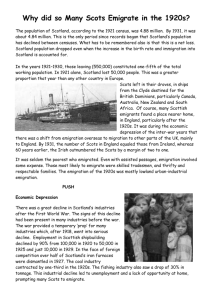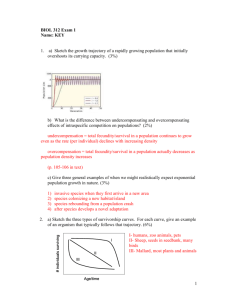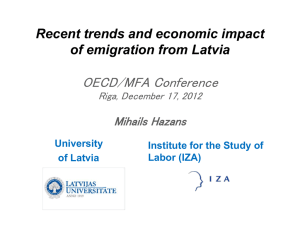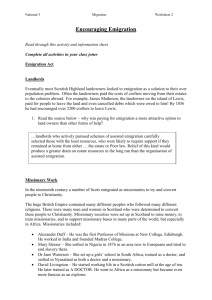Why Sid So Many Scots Emigrate in the 1920s
advertisement
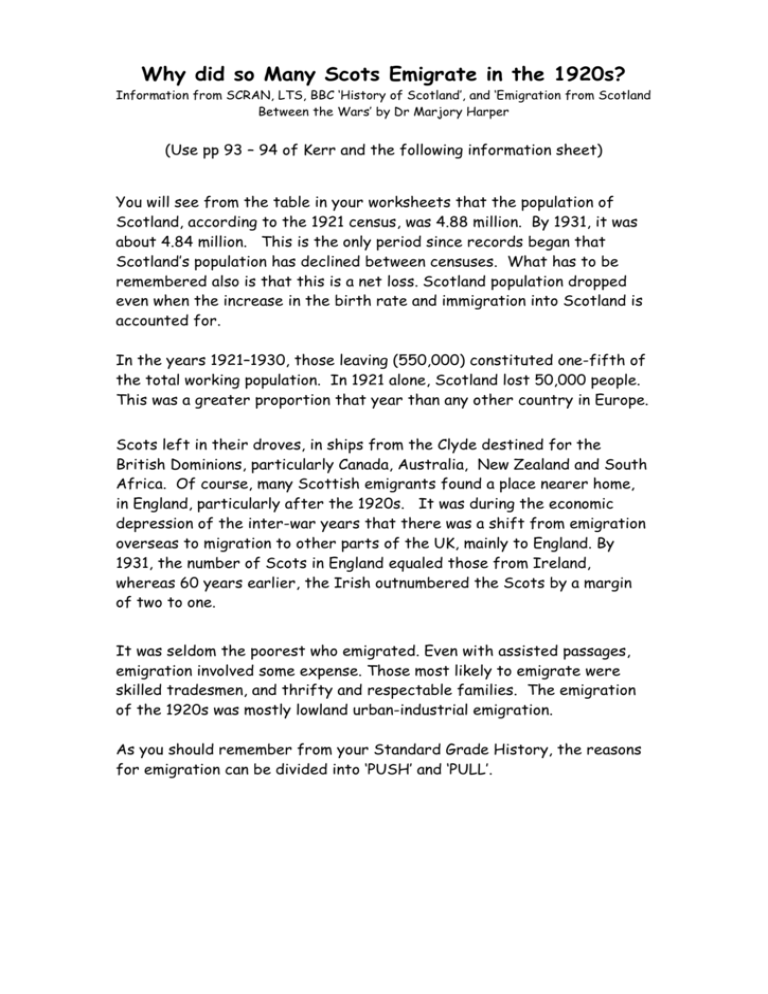
Why did so Many Scots Emigrate in the 1920s? Information from SCRAN, LTS, BBC ‘History of Scotland’, and ‘Emigration from Scotland Between the Wars’ by Dr Marjory Harper (Use pp 93 – 94 of Kerr and the following information sheet) You will see from the table in your worksheets that the population of Scotland, according to the 1921 census, was 4.88 million. By 1931, it was about 4.84 million. This is the only period since records began that Scotland’s population has declined between censuses. What has to be remembered also is that this is a net loss. Scotland population dropped even when the increase in the birth rate and immigration into Scotland is accounted for. In the years 1921–1930, those leaving (550,000) constituted one-fifth of the total working population. In 1921 alone, Scotland lost 50,000 people. This was a greater proportion that year than any other country in Europe. Scots left in their droves, in ships from the Clyde destined for the British Dominions, particularly Canada, Australia, New Zealand and South Africa. Of course, many Scottish emigrants found a place nearer home, in England, particularly after the 1920s. It was during the economic depression of the inter-war years that there was a shift from emigration overseas to migration to other parts of the UK, mainly to England. By 1931, the number of Scots in England equaled those from Ireland, whereas 60 years earlier, the Irish outnumbered the Scots by a margin of two to one. It was seldom the poorest who emigrated. Even with assisted passages, emigration involved some expense. Those most likely to emigrate were skilled tradesmen, and thrifty and respectable families. The emigration of the 1920s was mostly lowland urban-industrial emigration. As you should remember from your Standard Grade History, the reasons for emigration can be divided into ‘PUSH’ and ‘PULL’. PUSH Economic Depression As you should know already, there was a great decline in Scotland’s industries after the First World War. The signs of this decline had been present in many industries before the war. The war provided a temporary ‘prop’ for many industries which, after 1918, went into serious decline. Employment in Scottish shipbuilding declined from 100,000 in 1920 to 50,000 in 1925 and just 10,000 in 1929. (That’s a 90% decline.) In the face of foreign competition over half of Scotland’s iron furnaces were dismantled in 1927. The coal industry contracted by one-third in the 1920s. The fishing industry also saw a drop of 30% in tonnage. This industrial decline led to unemployment and a lack of opportunity at home, prompting many Scots to emigrate. Unemployment During the 1920s and 1930s the principal aim of the emigrants was to find work and wages and escape mass unemployment at home. This mostly affected the age group 16–29, skilled rather than unskilled workers and men rather than women. Around the steel town of Motherwell in the 1920s, unemployment rose from under 2,000 to over 12,000. Motherwell became of the worst hit places in Scotland. The unemployed of this town, many of whom were very skilled steel workers, were faced with the choice of working one week in three earning eleven pence a day, burying the dead in the town cemetery, the dole, or emigration. Land Shortage in the Highlands As you know, from the work we have done on the land issue in the Highlands, there was a great demand for land in the Highlands after the war. This demand was met with a shortage of available land, land-raids and ineffective government action. In 1923, after the tour made by Canadian government emigration agents, there were mass emigrations from Lewis. There was a great deal of hostility in the Highlands, and in particular Lewis, towards the British government’s promotion of emigration instead of land settlement. PULL The Scottish Tradition of Emigration In the period 1903 – 1914 Scotland had also seen the highest proportional emigration of any country in Europe, apart from Norway and Ireland. Scots who emigrated after the war were simply continuing the Scottish tradition of emigration. Family and Friends Nothing was more effective in persuading people to emigrate than encouraging letters from family and friends. Even more effective were remittances (pre-paid tickets) or money sent back by the emigrants to enable others to join them. In 1922 a 19-year old miner named Joseph Delaney and seven other members of his family left Glasgow for the USA with tickets paid for and employment in the USA arranged by Joseph’s uncles. Clusters of emigrants from one family or town built up abroad. A group of Scots from Armadale (in West Lothian) settled in Benton, Illinois, working in the mines. And a community of Broxburn (also in West Lothian) folk grew in Fernie, British Columbia, in the early years of the 20th century. Easier Travel In the 1850s it took around six weeks to cross the Atlantic; by the 1920s it took only a week. The reduction in travelling time allowed for temporary migration as well as permanent - something unthinkable in the days of sailing ships. If things did not work out in the New World then the price of a steamship ticket brought you back to your native land in a week. Government Assistance In 1921, the Overseas Settlement Committee, was set up in Britain with government support to provide assistance to people who wanted to emigrate. The Committee granted free passage to the Dominions to exservicemen and women until the end of March 1923. The scheme assisted over 80,000 emigrants, many of whom were Scots. The Empire Settlement Act 1922 In the 1920s, the British government saw emigration as a way to strengthen an increasingly fragile British Empire. This act gave government assistance of around £3 million a year for fifteen years to assist emigration schemes. Women were in great demand as domestic servants and as wives; both were in short supply in the early days of the colonies. 20% of the British emigrants to Canada who were assisted by the ESA were female domestic servants, many of whom would have been Scots. Under the ESA the British government also worked in partnership with the governments of the dominions to assist emigration. In 1925 Canada promoted the ‘3,000 Families Scheme’, which aimed to bring 3,000 British families to Canada with the promise of land from the Canadian government and long-term loans of up to £300 from the British government for the purchase of stock and equipment. Scottish emigrants had always had a preference for Canada over the USA, so there were a disproportionate number of Scots who participated in schemes such as this one. In 1924 the government of British Columbia (in Canada) ran a fisheries emigration scheme which targeted Highland fishermen in the Hebrides. Other Assistance Other assisted emigration schemes were run by companies such as the Canadian Pacific Railway Company and the Hudson’s Bay Company (a furtrading company). Emigration Agents There were hundreds of professional private and government emigration agents. Many of these agents were Scots who had already emigrated. The agents were paid by companies or governments to recruit Scottish emigrants for free or assisted passage schemes, through lectures and posters. A Canadian emigration agent conducted a lecture-tour of the Hebrides in 1923. There were Canadian government emigration offices in Glasgow, Aberdeen and Inverness. The Australian and New Zealand governments promoted their schemes through employment exchanges and ticket agencies, such as Mackay Brothers, which had offices in Aberdeen and Edinburgh. Church and Charity Charities had been organising assisted emigration schemes since the nineteenth century. Many of these schemes were organised by charities such as Barnardo’s and the Salvation Army. After the introduction of the Empire Settlement Act, these schemes received formal government assistance. From 1870 to the 1930s around 100,000 children, mainly orphans, were sent to the British dominions. Many of these children were Scots. Quarrier’s Orphan Homes of Scotland (based in Bridge of Weir, near Glasgow) had been running emigration schemes for young Scottish destitute children and orphans since before the war. These schemes continued after the war. Scots had a high profile in the emigration scheme launched by the YMCA in the 1920s. This scheme assisted emigrants who had been nominated by family and friends already abroad. The Church of Scotland became actively involved in emigration schemes in the 1920s. The Church offered supervised passages and assured employment for emigrants. The Church also trained young men for the purposes of emigration at Cornton Vale Farm Colony (near Stirling) and Craigielinn Farm Training School (near Paisley). Coming home The trend for emigration was brought to a halt in the 1930s as the world trade depression saw emigrants returning home. Indeed, the numbers leaving Scotland in the 1930s were at their lowest for a century.

